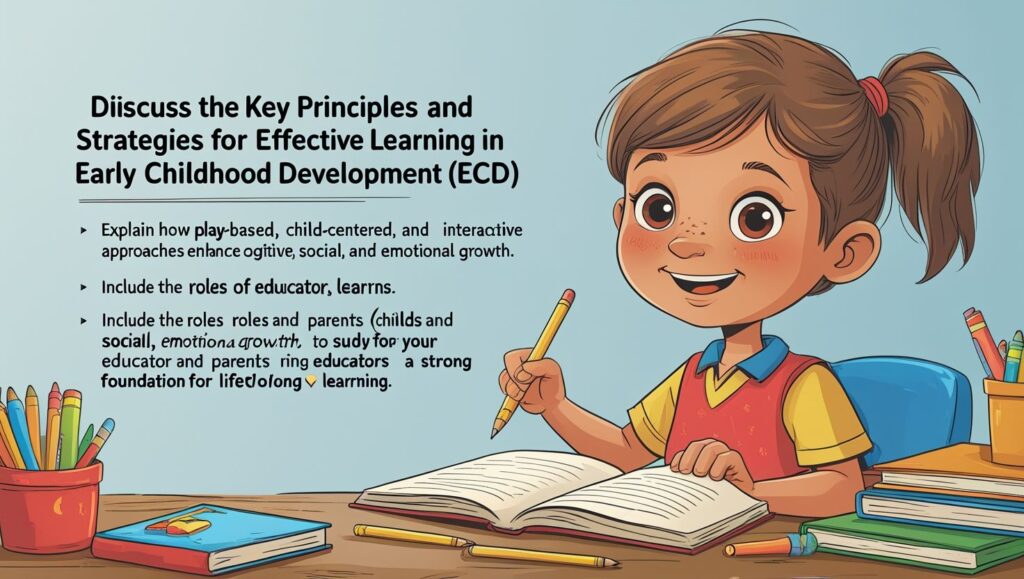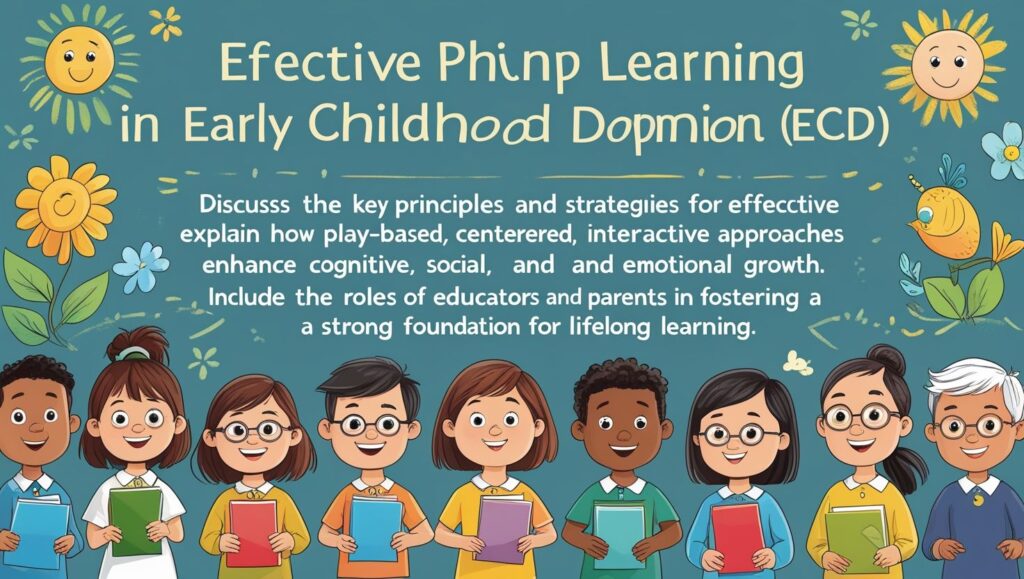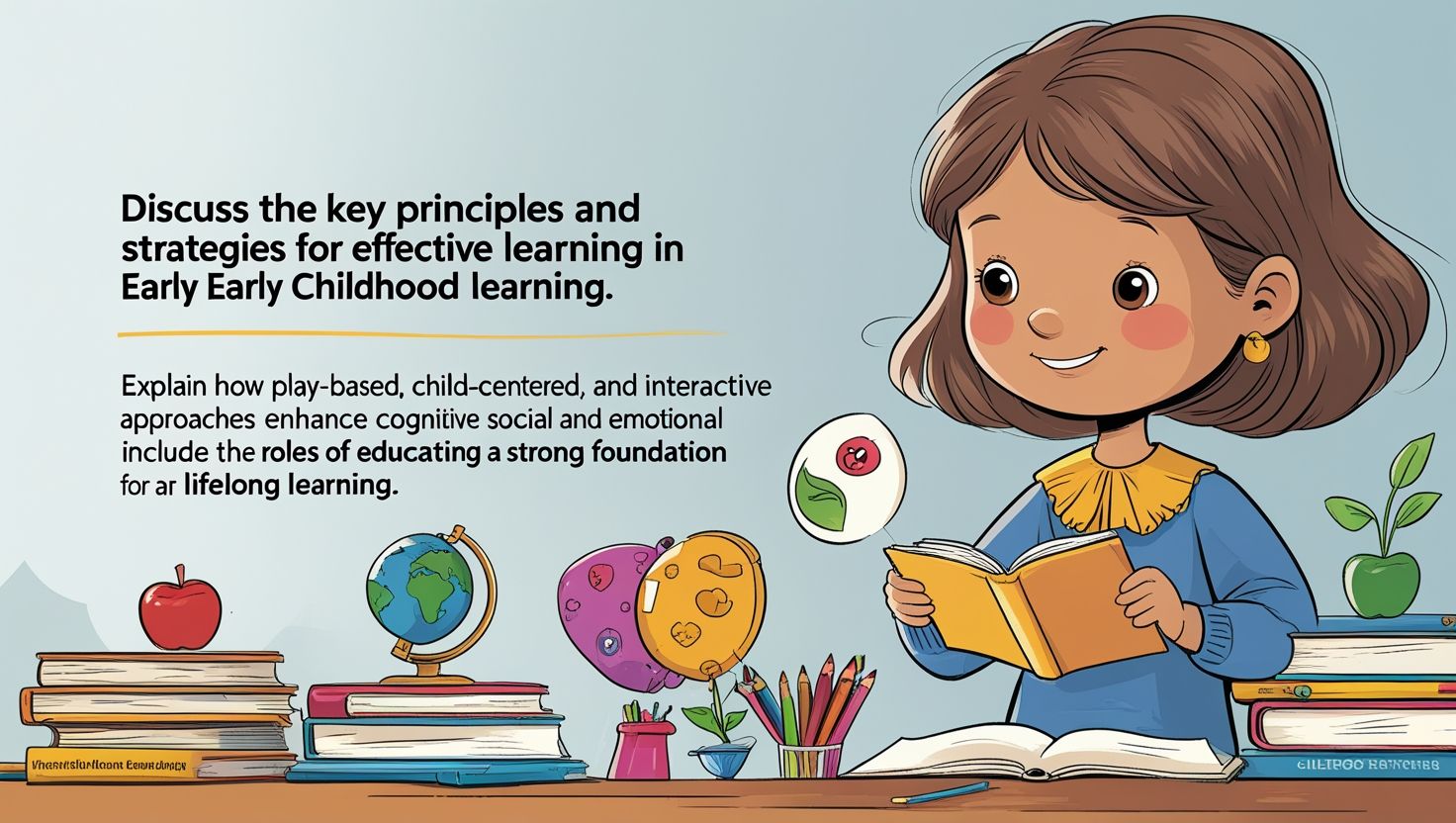Introduction
Effective Learning in Early Childhood Development (ECD), Early Childhood Development (ECD) is a crucial phase in a child’s life, spanning from birth to around eight years old. During this period, children undergo rapid cognitive, emotional, social, and physical growth. Effective learning in ECD lays the foundation for lifelong success by fostering curiosity, creativity, and critical thinking.
This article explores the principles of effective learning in ECD, key teaching strategies, the role of educators and parents, and best practices to enhance early childhood education.
1. Understanding Early Childhood Development (ECD)
Definition of ECD
ECD refers to the holistic development of a child’s brain, body, and socio-emotional skills during their early years. It encompasses:
- Cognitive Development (thinking, problem-solving, language)
- Social & Emotional Development (relationships, self-regulation, empathy)
- Physical Development (motor skills, health, nutrition)
Importance of ECD in Learning
- Brain Development – 90% of brain development occurs before age 5.
- Foundation for Future Learning – Strong ECD leads to better academic performance.
- Social Skills – Helps children develop communication and teamwork.
- Emotional Resilience – Builds confidence and coping mechanisms.
2. Principles of Effective Learning in ECD
For learning to be effective in early childhood, it should be:
1. Play-Based
- Children learn best through structured and unstructured play.
- Examples: Role-playing, puzzles, building blocks.
2. Child-Centered
- Learning should match the child’s interests and pace.
- Encourages autonomy and decision-making.
3. Interactive & Hands-On
- Sensory activities (touch, sound, sight) enhance retention.
- Example: Sand play, water experiments, art projects.
4. Language-Rich Environment
- Reading, storytelling, and conversations boost vocabulary.
- Encourages early literacy skills.
5. Socially Engaging
- Group activities teach sharing, cooperation, and empathy.
6. Safe & Supportive
- Emotional security enhances learning.
- Positive reinforcement builds confidence.

3. Key Teaching Strategies for Effective ECD Learning
A. Play-Based Learning
- Benefits: Enhances creativity, problem-solving, and motor skills.
- Methods:
- Free Play (child-directed activities)
- Guided Play (teacher-facilitated with learning goals)
B. Inquiry-Based Learning
- Encourages curiosity through questions and exploration.
- Example: “Why do leaves change color?” followed by nature walks.
C. Multisensory Learning
- Engages multiple senses (visual, auditory, kinesthetic).
- Example: Using clay to form letters (touch + sight).
D. Storytelling & Reading Aloud
- Develops language skills and imagination.
- Interactive reading (asking questions) improves comprehension.
E. Scaffolding & Zone of Proximal Development (ZPD)
- Teachers provide support just beyond the child’s current ability.
- Example: Helping a child write their name before expecting independence.
F. Positive Reinforcement
- Praise and rewards encourage desired behaviors.
- Example: Sticker charts for completing tasks.
4. The Role of Educators in ECD
1. Creating a Stimulating Environment
- Classrooms should be colorful, safe, and resource-rich.
- Learning corners (reading, art, science) encourage exploration.
2. Observation & Assessment
- Tracking progress through checklists and portfolios.
- Identifying learning delays early for intervention.
3. Individualized Attention
- Recognizing each child’s unique learning style.
- Adjusting teaching methods accordingly.
4. Parent-Teacher Collaboration
- Regular updates on child’s progress.
- Workshops for parents on reinforcing learning at home.
5. The Role of Parents in ECD Learning
1. Encouraging Learning at Home
- Reading bedtime stories.
- Engaging in educational games.
2. Providing Emotional Support
- Creating a loving, stress-free environment.
- Encouraging persistence in tasks.
3. Limiting Screen Time
- Prioritizing interactive play over passive screen use.
4. Modeling Positive Behavior
- Children imitate adults; demonstrating kindness, patience, and curiosity.

6. Challenges in ECD Learning & Solutions
| Challenge | Solution |
|---|---|
| Short attention spans | Use short, engaging activities |
| Diverse learning paces | Differentiated instruction |
| Limited resources | Use low-cost materials (recycled items, nature-based learning) |
| Behavioral issues | Positive discipline techniques |
7. Best Practices for Effective ECD Programs
1. High-Quality Preschool Programs
- Trained teachers, low student-teacher ratios.
- Structured yet flexible curriculum.
2. Incorporating Technology Wisely
- Educational apps (in moderation).
- Interactive whiteboards for group learning.
3. Outdoor & Nature-Based Learning
- Enhances physical health and curiosity.
- Example: Gardening, animal observations.
4. Inclusive Education
- Supporting children with disabilities.
- Culturally diverse learning materials.
8. Conclusion
Effective learning in Early Childhood Development is not just about academics but nurturing well-rounded individuals. By integrating play-based, interactive, and child-centered approaches, educators and parents can create a strong foundation for lifelong learning. Investing in quality ECD programs ensures brighter futures for children, fostering creativity, resilience, and a love for learning.

https://filedn.eu/lXvDNJGJo3S0aUrNKUTnNkb/marketing-78/research/je-tall-sf-marketing-1-(58).html
Stick to a small but stately earring and a cocktail ring, and keep further sparkle to a minimum.
https://digi482sa.s3.us-east-005.backblazeb2.com/research/digi482sa-(22).html
Always take into consideration the sorts of sleeves
and straps you’ll have on your dress.
https://digi20sa.fra1.digitaloceanspaces.com/research/digi20sa-(1).html
This mom’s knee-length patterned dress perfectly matched the mood of her child’s out of doors marriage ceremony venue.
https://objectstorage.ap-tokyo-1.oraclecloud.com/n/nrswdvazxa8j/b/digi494sa/o/research/digi494sa-(184).html
Neither a daytime occasion nor a proper summer time night soiree requires a full-length robe.
Hi! This is kind of off topic but I need some guidance from an established blog.
Is it hard to set up your own blog? I’m not very
techincal but I can figure things out pretty quick.
I’m thinking about setting up my own but I’m not
sure where to begin. Do you have any points or suggestions?
Many thanks
https://digi169sa.netlify.app/research/digi169sa-(338)
Not certain which shade will work to greatest coordinate the moms of the bride and groom with the the rest of the bridal party?
https://jekyll.s3.us-east-005.backblazeb2.com/20250729-6/research/je-marketing-(93).html
With over 3000 stores in america and worldwide, purchasing has turn out to be really easy.
https://je-tall-marketing-775.tor1.digitaloceanspaces.com/research/je-marketing-(267).html
Adhere to the gown code, and look to bridesmaids
or the marriage gown for steerage on bold patterns or embellishments.